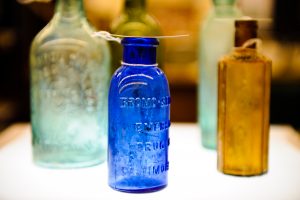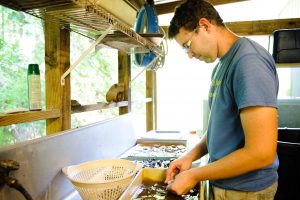
Editor’s note: Additional photos are available for publication. Contact Kim Eaton, UA media relations, at 205/348-8325 or kkeaton@ur.ua.edu.
TUSCALOOSA, Ala. — University of Alabama archaeologists are getting a glimpse of what life in Tuscaloosa might have been like more than 180 years ago. From bottles and porcelain pieces to soil and flotation samples taken from privies, or outhouses, the analysts are discovering many “stories” of Tuscaloosa’s past.
For the past two months, UA’s Office of Archaeological Research has been analyzing artifacts found at the former City Fest lot, located on the corner of University Boulevard and Greensboro Avenue. The University was contracted by the City of Tuscaloosa to perform an archaeological investigation per federal guidelines in preparation for construction of a new Embassy Suites hotel.
Beginning in January, project director Brandon Thompson and his team began investigating the “Bank of the State site.” In February, they stripped the remaining parking lot and exposed some “incredible” features, including many foundation remains from buildings that date back to before 1820, said Matt Gage, director of the Office of Archaeological Research.
Initial occupation of the site dates to 1816 when Revolutionary War veteran John Click built a log cabin on the property. However, he never got a deed to the property and lost it to John McKee in 1823. McKee was the Cherokee, Chickasaw and Choctaw agent at the time, as well as a land surveyor, and he had helped lay out the city of Tuscaloosa, Gage said.

Over the years, the property was home to numerous businesses, including Augustin Lynch’s cabinet manufactory. Known as one of the most important Antebellum furniture makers of the time, Gage said Lynch provided furniture for the Capitol building – at the time located only a few blocks to the west – and for some of the early University of Alabama buildings.
He also created ivory billiard balls and sold them to people in Washington, D.C. Gage said they discovered ivory on the site, as well as rusted tools such as saw blades and drills.
The Bank of the State was built on the property in 1829, and Gage said they found some beautiful decorative pieces from that building, as well as a few Spanish coins. The coins are reales minted in Brazil, Guatemala City and Mexico City. The coins were found in pits containing British gun flints and early bottles closer to where Click’s log cabin had been, so Gage predicted they were either associated with traders coming through Tuscaloosa or early dealings with the Bank of the State.
“In the early 1800s, foreign currency was used as frequently as coinage minted in the country,” he said. “There were so few mints in the U.S. at the time, any currency of monetary value made of gold, silver or copper was given value and could be exchanged as easily as currency minted in the U.S.”
The property also housed an ice factory, numerous shanties and other dwellings, a hotel and the Drish building, which was initially used as a warehouse and then a Civil War prisoner-of-war facility. Artifacts discovered included various bottles (including those that held food, as well as drink and medicine), buttons, porcelain pieces, printing press letters, early smoking pipes, architectural elements from the buildings and more.
A gold mine for archaeologists when it comes to historical sites are wells and privies, said Gage, and they found several on this site, including some that had been used by the Union soldiers housed at the Civil War prison. Using soil and flotation samples from the privies, analysts can determine everything from what individuals were eating to how they were being treated, he added.
“It’s just a wealth of information,” Gage said.
“Tuscaloosa has a very rich history. When you think of the early history of Tuscaloosa, even though the state capitol was here, you still figure that it was a small little enclave, people going about their lives with a predominant lifestyle involving agriculture, but commerce is a major aspect of this block,” Gage said.
“There are so many elements of this site that provide a fantastic glimpse of the past and knowing that past is incredibly important. You can never know who or what you are without knowing your history.”
Contact
Kim Eaton, UA media relations, 205/348-8325, kkeaton@ur.ua.edu
Source
Matt Gage, director of the Office of Archaeological Research, 205/371-2266, mdgage@bama.ua.edu